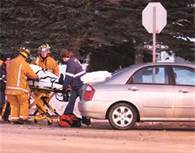NCSR: Societal Cost of Injury and Fatal Traffic Collisions on the Rise Since 2005
 |
WASHINGTON--Jan. 30, 3013: Traffic crashes kill tens of thousands of people and injure millions more every year in the United States. These tragic events exact substantial financial costs on loved ones burdened with emotional loss, as well as on the businesses, governments and insurers that make up the larger community.
Although the economic impact of an injury or fatal crash cannot compare to the human grief involved, it is useful in measuring how one collision affects an entire community on the financial level. Used by the National Highway Traffic Safety Administration, the societal perspective captures the full scope of collision costs.
The cost to the community of a fatal traffic accident is on the rise. Following an 87% increase from $3.2 million in 2005 to $6 million in 2009, the cost of just one accident continues to climb, reaching an estimated $6.4 million in 2012. When adjusted for inflation, this results in a 100 percent increase from 2005.
Injury crash costs follow the same upward trend. The community's cost of an injury crash is up 85 percent from $68,170 in 2005 to $126,000 in 2009. With inflation factored in, the cost rises to $134,555 in 2012, a 97 percent increase from 2005.
It is important to note that costs resulting from a collision are rising at a time when the number of fatal and injury crashes are on the decline. Costs would have been much higher had fatal crashes not declined 24 percent from 2005 to 2010, or had injury crashes not decreased 17 percent over the same time period. AAA attributes the decline in crashes in part to additional safety measures taken by states, regions and localities.
These climbing costs add to the already obvious safety reasons prompting communities to set better standards on roadways and drive down collisions. An important part in reducing fatal crashes is positively changing the behavior of drivers.
Red-light and speed safety cameras are technologies among those measures that have helped to change driver behavior and improve road safety. In the past decade, hundreds of communities have reduced crashes through the use of red-light safety cameras alone. As the number of communities using cameras grew from 25 in 2000 to 501 in 2010, cities experienced a decrease in red-light running violations and as a result, fewer traffic-related fatalities.
The reduction of fatal and injury traffic collisions not only saves lives but leads to real cost-saving benefits for U.S. communities.
Additional Statistics
Based on the most recent crash data available, here's a look at what traffic crashes cost society and insurers in 2010:
- 2.24 million injury crashes were reported in 2010 for a societal cost of $286 billion.
- 32,885 traffic fatalities were reported in 2010 for a societal cost of $200 billion.
- Each day, traffic crashes injured 6,136 people on average and cost communities $785 million.
- On average, 90 traffic fatalities occurred each day at a daily cost of $548 million.
- Insurers paid $392 million each day for traffic crash injuries.
- Insurers paid $274 million each day for traffic fatalities.
If red-light and speed safety cameras contribute a combined 25 percent reduction in fatalities alone, the impact on the insurance industry as a whole would be:
- A 25 percent reduction in the 10,395 speed-related deaths in 2010 would save 2,598 lives and $7.92 billion in insurer expenses.
- A similar reduction to the 673 people killed in red-light running crashes in 2010 would save 169 lives and $515 million in expenses to insurers.
- An estimated 122,000 people were injured in red-light running crashes in 2010. A 25 percent reduction would prevent 30,500 people from injuries and save insurers $1.95 billion.
To learn more about the benefits of red-light safety cameras please visit NCSR Safety.


